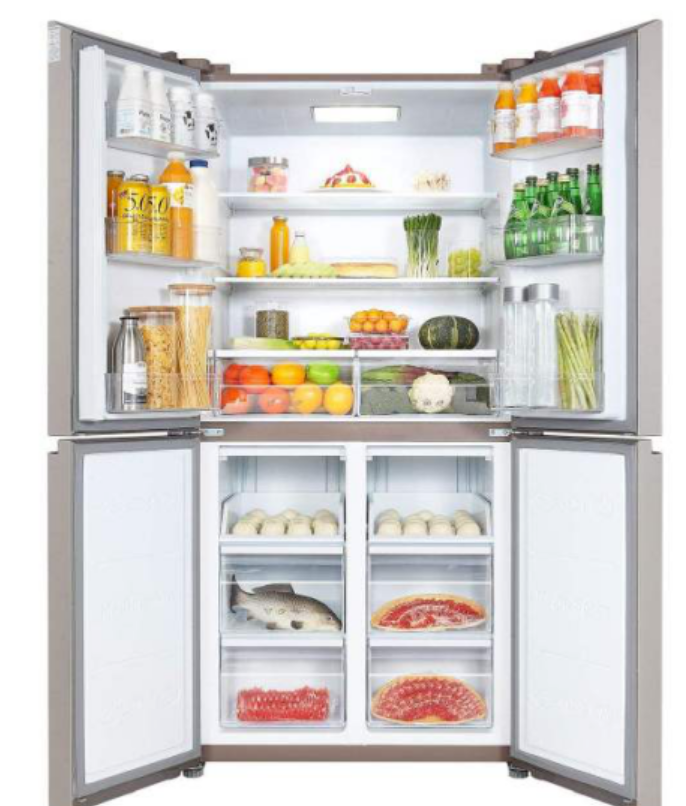What are the differences between medical refrigerators and domestic refrigerators? It has always been a problem that everyone pays attention to and mentions.
We’ve sorted out the differences in ten aspects, the following is a detailed explanation of the differences between the two.
1 Different Storage Items


Fruits, vegetables, beverages, pork, fish, etc. are generally stored in the domestic refrigerators.
2 Different Temperature Control Range
The range of temperature in the domestic refrigerator compartment is 0℃~10℃ with undemanding temperature fluctuation, and there is a risk of freezing and frost in the cabinet. If reagents and vaccines are placed in a domestic refrigerator, the sudden rises and falls of the temperature in the compartment will cause the reagents and vaccines to lose their activity and even cause medical accidents.
The temperature range of the medical refrigerator is 2℃~8℃, and the temperature fluctuation range is 5±3℃. The setting temperature of the medical blood bank refrigerator is 4℃ (4℃ is also called biological zero), and the temperature fluctuation range can even be 4±1℃.
3 Different number of sensors
Domestic refrigerators generally have only one temperature sensor, and the temperature of the refrigerator differs greatly when the compressor is started and stopped. It shall be ensured that the food is fresh and not spoiled, so the temperature fluctuation is great.
Medical refrigerators generally have 2 to 3 temperature sensors, or even more, to ensure the accuracy of the temperature inside. Even if the door is opened frequently, the temperature control system can quickly adjust to keep the temperature stable.
4 Different Compressor Types
The low-cost low-pressure compressor used in domestic refrigerators evaporates in a moment of cooling, and the temperature drops quickly, easily causing the stored items in the refrigerator to be frozen.
For medical refrigerators, especially blood bank refrigerator, in order to ensure a stable temperature drop in the cabinet and reduce temperature fluctuations, a mid-back pressure compressor with a higher cost should be used instead.
5 Different cooling methods
In order to save energy and costs, domestic refrigerators mostly are equipped with direct cooling auxiliary fans. The evaporator of the direct-cool refrigerator is close to the inner wall where the temperature is pretty low (much lower than the temperature during use). Natural convection heat transfer is carried out inside, with big temperature difference in the refrigerator. When medicines or vaccines are stacked too close to the inner wall, frost damage occurs.
The refrigerated medical medicinal box is a comprehensive layout of finned evaporators, equipped with a suitable fan circulation so that the temperature in each part of the box is the same. It generally adopts the fin-type air cooling structure, which has strict requirements on the temperature uniformity and fluctuation of the refrigerator. There is a specially designed back air duct inside to isolate the cold source, which ensures a uniform, constant temperature and storage safety of biological products such as reagents and vaccines.
6 Different alarm functions
Ordinary domestic refrigerators have no alarm function, some high-end ones have an over-temperature alarm function.
The medical refrigerator alarm function is relatively complete and comprehensive. General medical refrigerators are equipped with basic alarm functions such as high and low-temperature alarms, thermostat failure alarms, power failure alarms, door opening and closing alarms, and high ambient temperature alarms. In addition to the above, the medical low-temperature refrigerator also has expanded alarm functions such as condenser congestion alarm, sensor failure alarm, low battery alarm, and abnormal voltage alarm. It has two kinds of alarm methods at the same time, reminding users to observe and pay attention by sounding beeps and flashing lights.
7 Different thermostat types
Domestic refrigerators generally are equipped with mechanical thermostats with adjustable ranges from 1 to 7 digits, while high-end ones with LED digital thermostats to display the temperature set inside.
The medical refrigerator has an electronic temperature controller with LED digital display or liquid crystal display, which intuitively display the operating and alarm status in, and the real-time temperature.
8 Different temperature control accuracy
Domestic refrigerators with ordinary mechanical thermostats fail to display control accuracy, while high-end ones adopt digital display thermostats with an accuracy of 1°C.
Medical refrigerator adopts electronic thermostat, temperature display and control accuracy can reach 0.1 °C.
9 The thickness of the insulation layer is different
The thickness of the insulation layer of domestic refrigerators is generally 20-45mm polyurethane foam.
The high-density polyurethane foam with a thickness of 40-50mm for the insulation layer of the pharmaceutical freezers, and the wall thickness of the insulation layer of the low-temperature freezer at -86℃ can reach 120-160mm. Generally, the thicker the insulation layer, the better the insulation performance.
10 Different internal and external materials
The external material of the cabinet of the domestic refrigerator generally uses PCM (color steel plate, also known as color coated steel plate, is a steel plate with organic coating), VCM (film plate, refers to the surface of the metal plate covered with PVC or PET film). The inner liner material is generally made of plastic ABS (acrylonitrile-butadiene-styrene copolymer) or PS (polystyrene plastic).
Cold-rolled sprayed steel plates are generally used on the outside of the medical refrigerators, and cold-rolled sprayed steel plates, electro-galvanized steel plates or 304 stainless steel are covered inside, which has better corrosion and rust resistance.


